-
University Guide
 University Guide
University Guide
INDEX- Introducing the President
- University Introduction
- University Evaluation
-
Policies and Initiatives
- Policy and Initiatives INDEX
- Compliance
- Crisis Management System
- Promoting gender equality
- International Exchange Policy
- Infrastructure longevity plan (individual construction plan)
- Environmental Initiatives
- Smoking is prohibited throughout the university grounds.
- Safety Management Action Plan
- JABEE Initiatives
- Basic rules regarding drinking among Muroran Institute of Technology students
- Policy for promoting the sharing of research facilities and equipment at Muroran Institute of Technology
- Campus Master Plan
- Muroran Institute of Technology Conflict of Interest Management Policy
- Digital Campus Promotion
- Muroran Institute of Technology Open Access Policy
- Muroran Institute of Technology Research Data Policy
-
Information Disclosure
- Information Disclosure INDEX
- Disclosure of corporate information (information about the organization)
- Disclosure of corporate information (information regarding business)
- Disclosure of corporate information (financial information)
- Publication of corporate information (evaluation information)
- Disclosure of corporate information (audit information)
- Publication of educational information
- Compliance status with the National University Corporation Governance Code
- Rules
- Information Disclosure System
- Personal Information Protection System
- Publication of guidelines for employees regarding the promotion of the elimination of discrimination against people with disabilities
- Announcement of the New Support System for Higher Education
- Application and recruitment information
- public relations
-
Faculty/Graduate School/Center etc.
 Faculty/Graduate School/Center etc.
Faculty/Graduate School/Center etc.
INDEX- Faculty of Science and Engineering
- graduate school
-
Affiliated facilities (centers, etc.)
- Affiliated Facilities (Centers, etc.) INDEX
- Creative Collaboration Center
- Aerospace Plane Research Center
- Rare Earth Materials Research Center
- Computer Science Center
- Research Infrastructure Equipment Sharing Center
- Technology Department
- Career Support Center
- International Exchange Center
- Information Education Center
- Affiliated Library
- Health Management Center
- Gender Equality Promotion Office
- MONO Creation Future Co-Creation Organization
- Regional Collaboration Human Resources Development Center
- Manufacturing Infrastructure Center
- Robot Arena
- satellite
- Tokyo Office
- the study
-
Student Life/Employment
 Student Life/Employment
Student Life/Employment
INDEX-
Courses and classes
- Course/Class INDEX
- Academic Calendar
- Lesson plan (syllabus)
- Classes (timetable)
- Exam (timetable)
- Course Affiliation
- Credit transfer with other universities
- Re-reading of course subjects
- CAMPUS SQUARE (Course registration)
- How to take the course
- Student Handbook/Graduate School Course Guidelines
- Transfer of departments, etc.
- Doctoral Degree Application Guide
- Academic Counseling and Guidance
- Duration of study
- Long-term student system
- Educational Programs (not required for graduation or completion)
- A Note About Generative AI
-
Student Life
- Student Life INDEX
- Suspension and Absence
- Various notification and certificate issuance procedures
- Student ID and student number
- Student discount card/school attendance certificate
- Procedures for taking a leave of absence, reinstating, and withdrawing from school
- New academic year orientation
- Preserving the on-site environment
- Attention students
- Transportation on and off campus
- Message board/contact method
- Harassment
- health care
- Events
- Welfare facilities
- Student Dormitory
- Student Support Center Introduction
- Student General Advice Office
- Extracurricular Activities
- Tuition, scholarships and other procedures
- Employment and qualification support
-
Courses and classes
-
Entrance Examination Information
 Entrance Examination Information
Entrance Examination Information
INDEX- University Entrance Examination [Faculty]
- Graduate School Entrance Examination
- Transfer Admissions
- Entrance examination for international students
- Specialized students and research students
- Admission procedures, tuition fees, etc.
- FAQ
- University Introduction
- Request information

-
Social Cooperation
 Social Cooperation
Social Cooperation
INDEX- Collaborative News
- Collaboration Centers, etc.
-
Industry-academia-government collaboration
- Industry-academia-government collaboration INDEX
- Alliance Lab
- Research Collaboration Association
- Muro Institute of Technology venture title
- Confidentiality
- Joint Research System
- Commissioned Research System
- Academic Guidance System
- Tangible research results
- Scholarship and Donation System
- Donation field etc.
- Future Creation Promotion Expenses
- Regarding the expenditure of personnel expenses of the principal investigator (PI) from direct costs of competitive research grants
- Research ethics and safety
- Public Lectures
- Muro Institute of Technology Science School
- University Visit
- Robot Soccer Contest
- Re-education for working adults
-
International Exchange
 International Exchange
International Exchange
INDEX- International Academic Exchange Agreements
- Number of international students
- Researcher Database
- Entrance Exam
- Tuition Fees
- International Student Support (for new students)
-
Support for international students (for current students)
- Scholarships for International Students
- Japanese Language Course for International Students
- Immigration procedures (renewal of period of stay, permission to engage in activities other than those permitted under the status of residence, re-entry permission)
- Procedures after arriving in Japan
- Procedures for changing address (under construction)
- Procedures upon returning to Japan
- Notification of absence due to temporary return to Japan, travel, etc.
- Employment for international students
- Emergency Contact Information
- Studying abroad from Muro Institute of Technology
- Request for donations
-
University Guide
University Guide INDEX
- Introducing the President
- University Introduction
- University Evaluation
-
Policies and Initiatives
- Policy and Initiatives INDEX
- Compliance
- Crisis Management System
- Promoting gender equality
- International Exchange Policy
- Infrastructure longevity plan (individual construction plan)
- Environmental Initiatives
- Smoking is prohibited throughout the university grounds.
- Safety Management Action Plan
- JABEE Initiatives
- Basic rules regarding drinking among Muroran Institute of Technology students
- Policy for promoting the sharing of research facilities and equipment at Muroran Institute of Technology
- Campus Master Plan
- Muroran Institute of Technology Conflict of Interest Management Policy
- Digital Campus Promotion
- Muroran Institute of Technology Open Access Policy
- Muroran Institute of Technology Research Data Policy
-
Information Disclosure
- Information Disclosure INDEX
- Disclosure of corporate information (information about the organization)
- Disclosure of corporate information (information regarding business)
- Disclosure of corporate information (financial information)
- Publication of corporate information (evaluation information)
- Disclosure of corporate information (audit information)
- Publication of educational information
- Compliance status with the National University Corporation Governance Code
- Rules
- Information Disclosure System
- Personal Information Protection System
- Publication of guidelines for employees regarding the promotion of the elimination of discrimination against people with disabilities
- Announcement of the New Support System for Higher Education
- Application and recruitment information
- public relations
-
Faculty/Graduate School/Center etc.
Faculty/Graduate School/Center etc. INDEX
- Faculty of Science and Engineering
- graduate school
-
Affiliated facilities (centers, etc.)
- Affiliated Facilities (Centers, etc.) INDEX
- Creative Collaboration Center
- Aerospace Plane Research Center
- Rare Earth Materials Research Center
- Computer Science Center
- Research Infrastructure Equipment Sharing Center
- Technology Department
- Career Support Center
- International Exchange Center
- Information Education Center
- Affiliated Library
- Health Management Center
- Gender Equality Promotion Office
- MONO Creation Future Co-Creation Organization
- Regional Collaboration Human Resources Development Center
- Manufacturing Infrastructure Center
- Robot Arena
- satellite
- Tokyo Office
- the study
-
Student Life/Employment
Student Life/Employment INDEX
-
Courses and classes
- Course/Class INDEX
- Academic Calendar
- Lesson plan (syllabus)
- Classes (timetable)
- Exam (timetable)
- Course Affiliation
- Credit transfer with other universities
- Re-reading of course subjects
- CAMPUS SQUARE (Course registration)
- How to take the course
- Student Handbook/Graduate School Course Guidelines
- Transfer of departments, etc.
- Doctoral Degree Application Guide
- Academic Counseling and Guidance
- Duration of study
- Long-term student system
- Educational Programs (not required for graduation or completion)
- A Note About Generative AI
-
Student Life
- Student Life INDEX
- Suspension and Absence
- Various notification and certificate issuance procedures
- Student ID and student number
- Student discount card/school attendance certificate
- Procedures for taking a leave of absence, reinstating, and withdrawing from school
- New academic year orientation
- Preserving the on-site environment
- Attention students
- Transportation on and off campus
- Message board/contact method
- Harassment
- health care
- Events
- Welfare facilities
- Student Dormitory
- Student Support Center Introduction
- Student General Advice Office
- Extracurricular Activities
- Tuition, scholarships and other procedures
- Employment and qualification support
-
Courses and classes
- Entrance Examination Information
-
Social Cooperation
Social Collaboration INDEX
- Collaborative News
- Collaboration Centers, etc.
-
Industry-academia-government collaboration
- Industry-academia-government collaboration INDEX
- Alliance Lab
- Research Collaboration Association
- Muro Institute of Technology venture title
- Confidentiality
- Joint Research System
- Commissioned Research System
- Academic Guidance System
- Tangible research results
- Scholarship and Donation System
- Donation field etc.
- Future Creation Promotion Expenses
- Regarding the expenditure of personnel expenses of the principal investigator (PI) from direct costs of competitive research grants
- Research ethics and safety
- Public Lectures
- Muro Institute of Technology Science School
- University Visit
- Robot Soccer Contest
- Re-education for working adults
-
International Exchange
International Exchange Index
- International Academic Exchange Agreements
- Number of international students
- Researcher Database
- Entrance Exam
- Tuition Fees
- International Student Support (for new students)
-
Support for international students (for current students)
- Scholarships for International Students
- Japanese Language Course for International Students
- Immigration procedures (renewal of period of stay, permission to engage in activities other than those permitted under the status of residence, re-entry permission)
- Procedures after arriving in Japan
- Procedures for changing address (under construction)
- Procedures upon returning to Japan
- Notification of absence due to temporary return to Japan, travel, etc.
- Employment for international students
- Emergency Contact Information
- Studying abroad from Muro Institute of Technology
- Request for donations
- HOME
- Faculty/Graduate School/Center etc.
- Faculty of Science and Engineering
- Department of System Science and Chemistry
- Chemical and Biological Systems Course
Chemical and Biological Systems Course
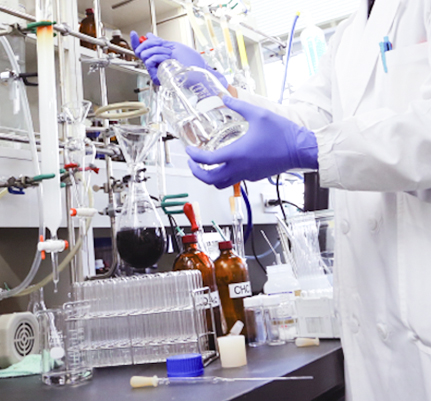
I want to study nature scientifically and discover new phenomena! I want to use the power of molecules to bring safety and security to our lives!
We provide education and research that combines chemistry and biology, which are fields of science that seek to elucidate natural phenomena, particularly by viewing familiar local resources and assets as chemical and biological systems and exploring their true nature, with informatics (the science and engineering of information), which provides the means to extract and utilize data related to these essences.
About the Education Program
Learn chemistry and biology from multiple angles and explore their applications
From the first year to the first half of the second year, students take general education subjects, faculty and department-wide (natural science) subjects, and some information-related subjects to acquire communication skills and social literacy, as well as a wide range of knowledge about natural sciences (mathematics, physics, chemistry, biology) and basic knowledge about information science. From the second half of the second year onwards, this course divides chemistry and biology, which are sciences that analyze phenomena related to matter and life at the molecular level in relation to their structure and properties, into physical chemistry, inorganic/analytical chemistry, organic chemistry, biochemistry/biology, and applied chemistry/biology, and systematically takes subjects in each field. In addition, students will apply the knowledge they have acquired in information-related subjects in specialized subjects and learn how to apply it to practical information methods.
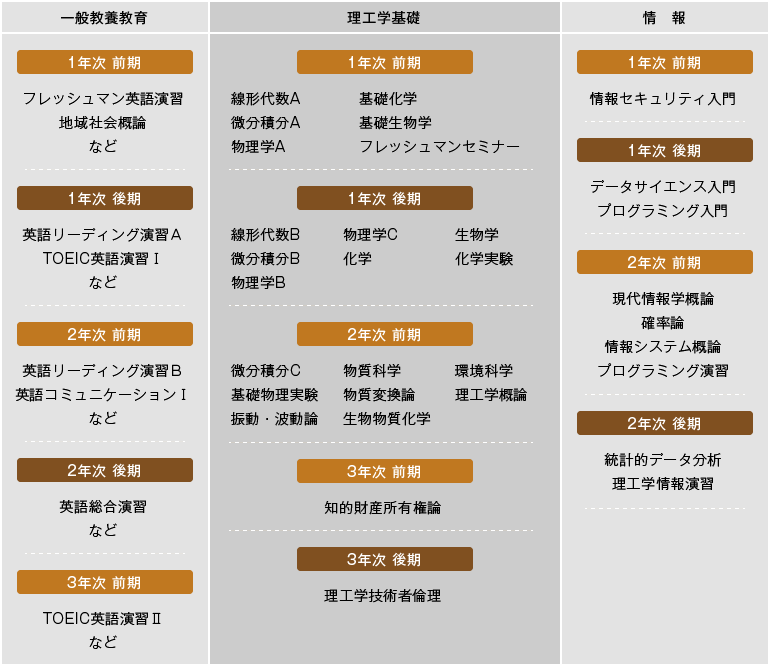
Chemical and Biological Systems Course
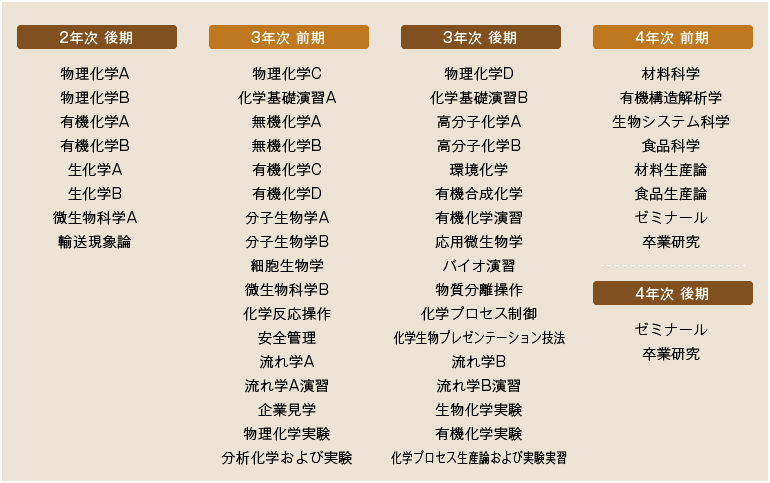
Flow of the four years
First year
General education subjects include subjects related to people and society, foreign languages, regional collaboration subjects, common natural science subjects including mathematics, physics, chemistry, and biology, and information-related subjects including information security, data science, and programming.
Second Year
Students will learn about natural sciences across disciplines through subjects such as "Material Transformation Theory," "Biomaterial Chemistry," "Vibration and Wave Theory," and "Material Science," and will also learn about information science through subjects such as "Introduction to Modern Informatics," "Probability Theory," "Statistical Data Analysis," and "Introduction to Information Systems." From the second semester, students will begin taking specialized subjects in each course.
Third Year
Continuing from the second semester of the second year, students will focus on studying specialized course subjects. Students will take subjects such as "physical chemistry," "inorganic chemistry," "analytical chemistry," "organic chemistry," "biochemistry," and "microbial science" to acquire a wide range of specialized knowledge related to their field, and will also conduct computer-assisted experiments and exercises to integrate and utilize this knowledge.
Fourth Year
The main part of learning in the fourth year is practical, through graduation research. By applying the knowledge acquired up to that point to problems set in each field, students will make their knowledge more essential and develop their problem-solving skills.
Chemical and Biological Systems Course Pickup
About the classes
Molecular Biology
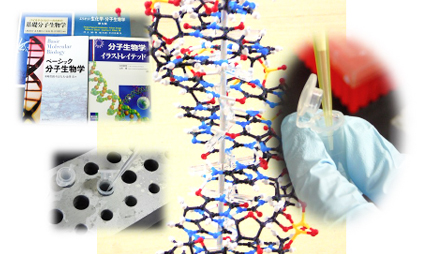
The structure and function of DNA, the body of genes, are the basis of molecular biology. This course aims to understand molecular biology based on the flow of genetic information, from DNA to genomes, from structure to function and control, from prokaryotes to eukaryotes. Molecular biology explains and understands the phenomenon of life, especially the phenomenon of genetics, at the molecular level below the cell. Starting with the molecular structures of DNA, RNA and proteins, students will learn how their relationships create life through intangible genetic information. It is not simply a case of A and B binding together, but rather the timing, strength and amount of binding are beautifully controlled. The class will proceed while students make use of their individual abilities, just as molecules cooperate with each other.
About the Research
Searching for anti-dementia substances from natural substances produced in Hokkaido
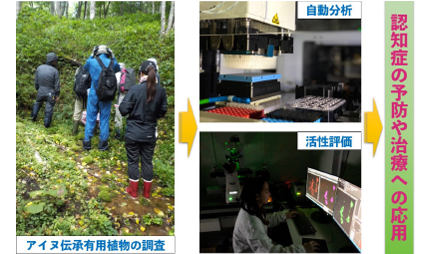
In our bodies, normal proteins cooperate with each other to carry out vital activities, but when these proteins denature and form abnormal aggregates, they can cause disease. For example, it is said that the abnormal aggregation of amyloid beta and tau proteins is involved in the onset of Alzheimer's disease, and that the abnormal aggregation of a protein called alpha-synuclein is involved in the onset of Lewy body dementia. We have succeeded in developing an evaluation system that visualizes these proteins using nanometer-sized fluorescent substances and efficiently searches for minute amounts of substances that suppress abnormal aggregation. Currently, we are using this method to search for substances that are useful for preventing and treating dementia from natural resources in Hokkaido, such as Ainu traditional useful plants and seaweed.
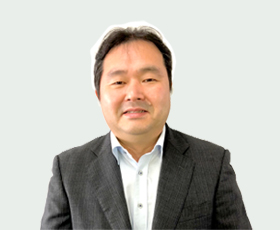
Professor Kiyotaka Tokura
Research Field
Protein Chemistry
Main research themes
Searching for anti-dementia substances from natural substances produced in Hokkaido
Licenses and qualifications available
driver licence
- High school teacher's license (science), etc. *Teacher training course credits required
Qualifications
- Poisonous and hazardous substance handling officer (exemption from qualification examination)
- Class A Hazardous Materials Handler (Qualification Exam Eligibility)
- Assistant Engineer, etc.
Employment situation
- Ivy Cosmetics
- Iwai Machinery Industry
- Organo
- Kanto Glico
- Kirin Engineering
- Sanei Chemical
- JX Engineering
- J.N.C.
- Showa Denko
- Nippon Paper Industries
- Senju Metal Industry
- Takenaka Corporation
- Tamapoli
- Tsukishima Environmental Engineering
- DIC
- Toyo Aluminium
- Nippon Steel Tex Engineering
- Nipro
- Japan Blood Products Organization
- Nippon Chemi-Con
- Hokuren Agricultural Cooperative Association
- Air Water Hokkaido
- Hokkaido Gas
- Hokkaido Electric Power
- Maruzen Petrochemical
- Mitsubishi Hitachi Power Systems
- Mitsubishi Materials
- Yotsuba Milk Industry
- Royce Confect
- Lotte
- Hokkaido Prefectural Government
- Date City Hall
- High school teacher (Hokkaido, Aomori), etc.


